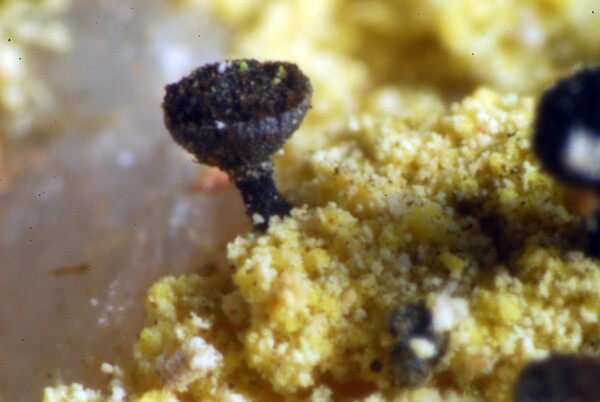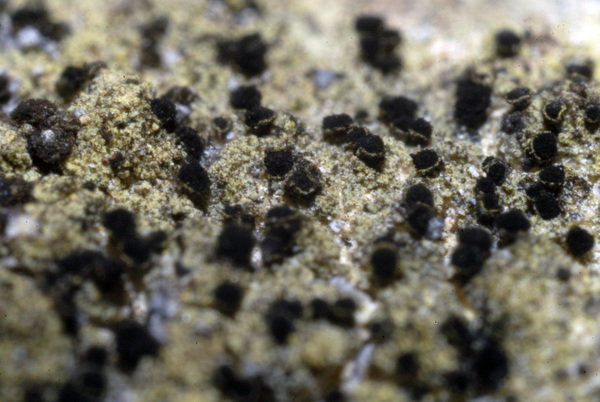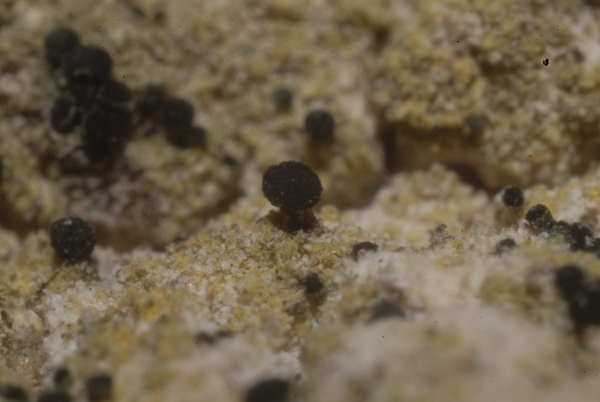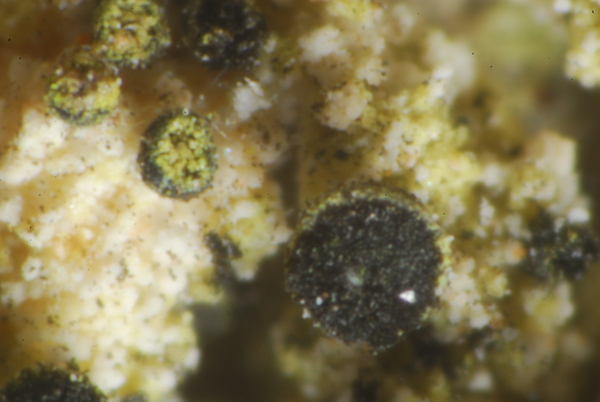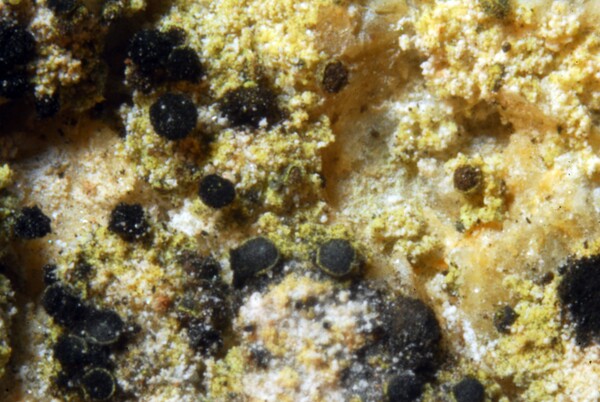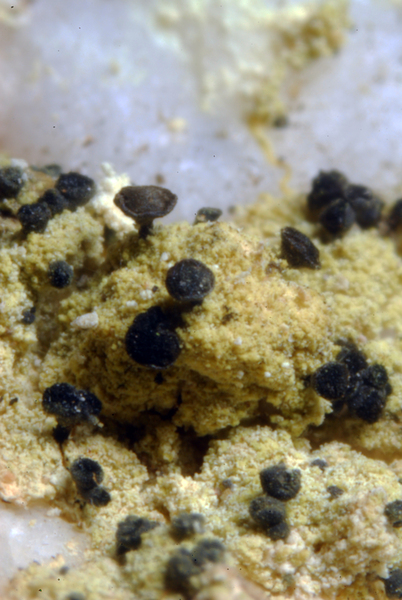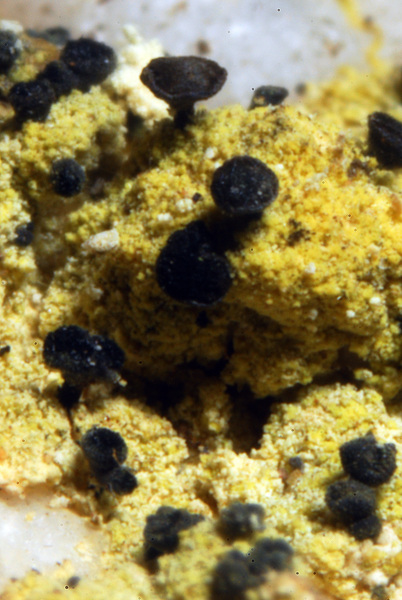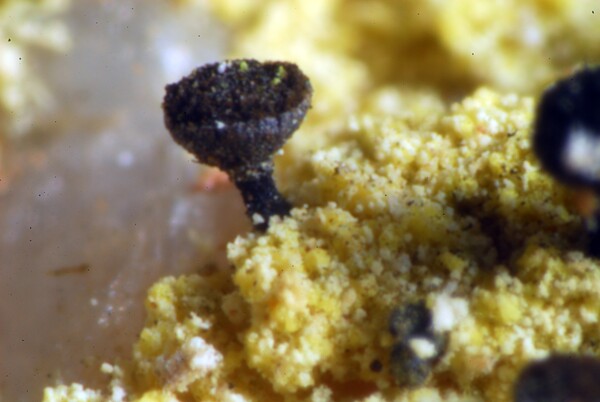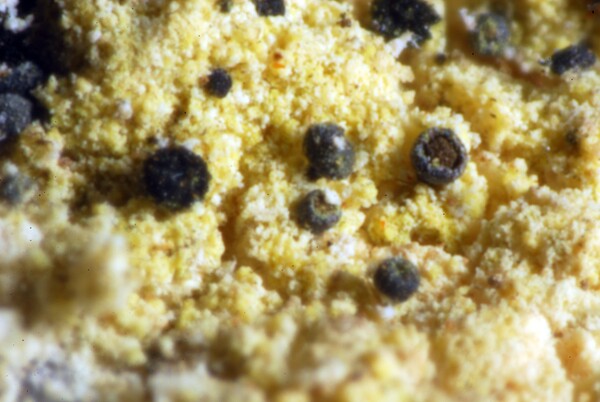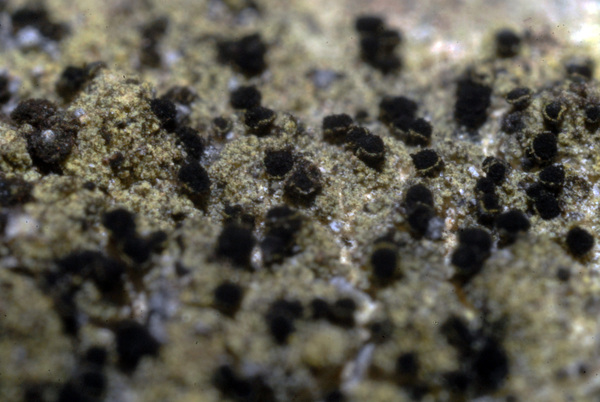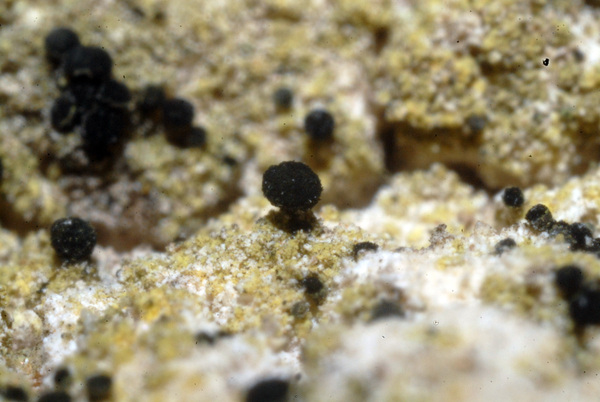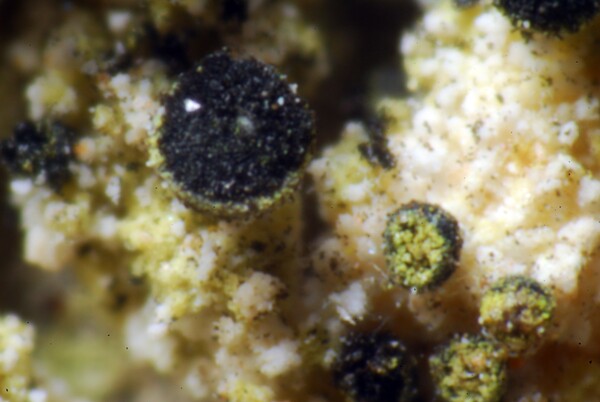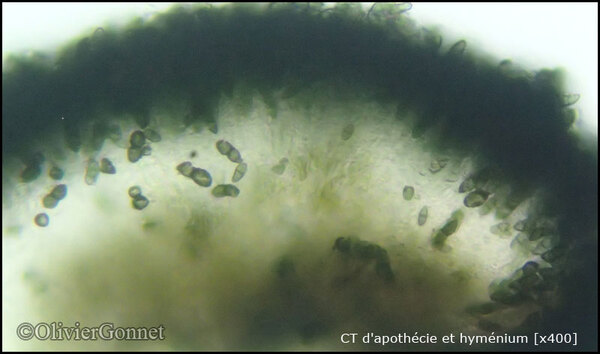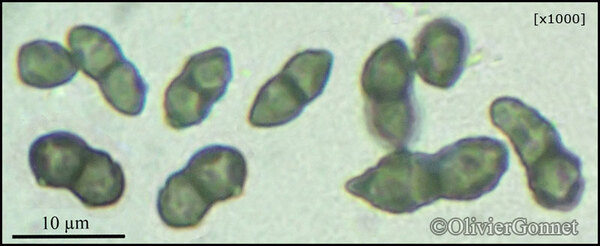Calicium corynellum (Ach.) Ach.
Meth. Lich.: 94, 1803. Basionym: Lichen corynellus Ach. - Lichenogr. Suec. Prodr.: 85, 1799.
Synonyms: Caliciella corynella (Ach.) Vain.; Calicium paroicum Ach. non auct.; Cyphelium chlorinum auct. ital. non (Ach.) Kremp.; Sphinctrina paroica (Ach.) Trevis.; Strongyleuma paroicum (Ach.) Vain. non auct.
Distribution: N - Ven (Puntillo & Puntillo 2009), TAA (Puntillo & Puntillo 2009), Lomb (Puntillo & Puntillo 2009), Piem (Isocrono & al. 2004, Puntillo & Puntillo 2009), VA (Puntillo & Puntillo 2009). C - Tosc (Puntillo & Puntillo 2009), Sar (Puntillo & Puntillo 2009). S - Bas (Ravera 2014b, Puntillo & Potenza 2014), Cal (Puntillo 1994, 1996, Puntillo & Puntillo 2009, Brackel & Puntillo 2016), Si (CLU 3942).
Description: Thallus crustose, episubstratic, rather thick and usually well-evident, granular to subleprose, greenish. Apothecia short-stalked, 0.5-0.6 mm tall, black with a thin whitish pruina which is most abundant on the lower side of capitulum. Stalk 0.07-0.13 mm thick, of moderately sclerotized, dark, anticlinally arranged, irregularly interwoven hyphae. Capitulum lenticular, 0.25-0.4 mm across, with a well-developed, cup-shaped exciple of largely anticlinally arranged, strongly sclerotized hyphae; mazaedium well developed, black; hypothecium medium brown, with a flat upper surface, of intertwined, 2-2.5 µm thick hyphae. Asci clavate, formed singly, dissolving early, with 2-3 seriate ascospores. Ascospores 1-septate, constricted at septum, dark brown, ellipsoid, 12-14(-16) x 4-6 µm, the wall thick, at first with spirally arranged ridges, then coarsely cracked. Photobiont chlorococcoid. Spot tests: thallus K-, C-, KC-, P-; ascomata I- in all parts. Chemistry: thallus with rhizocarpic and usnic acids.Note: a temperate, probably holarctic species found on rain-sheltered faces of hard siliceous rocks in humid areas; probably more widespread, but never common.
Growth form: Crustose
Substrata: rocks
Photobiont: green algae other than Trentepohlia
Reproductive strategy: mainly sexual
In underhangs rarely wetted by rain
Commonnes-rarity: (info)
Alpine belt: absent
Subalpine belt: absent
Oromediterranean belt: absent
Montane belt: very rare
Submediterranean belt: extremely rare
Padanian area: absent
Humid submediterranean belt: very rare
Humid mediterranean belt: absent
Dry mediterranean belt: absent

Predictive model
Herbarium samples
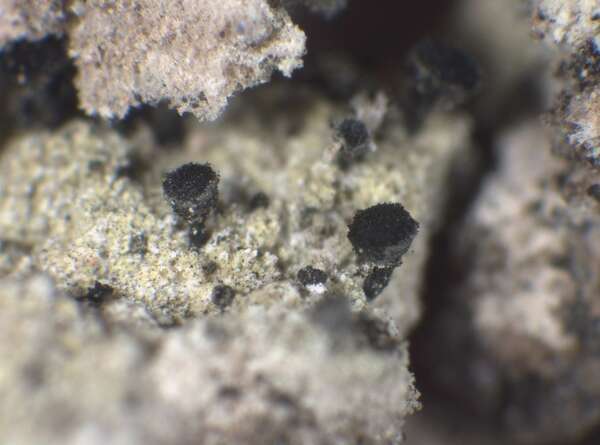

P.L. Nimis; Owner: Department of Life Sciences, University of Trieste
Herbarium: TSB (26121)
2003/03/12


E. Pittao; Owner: Department of Life Sciences, University of Trieste
Herbarium: TSB (11836)
2008.03.10
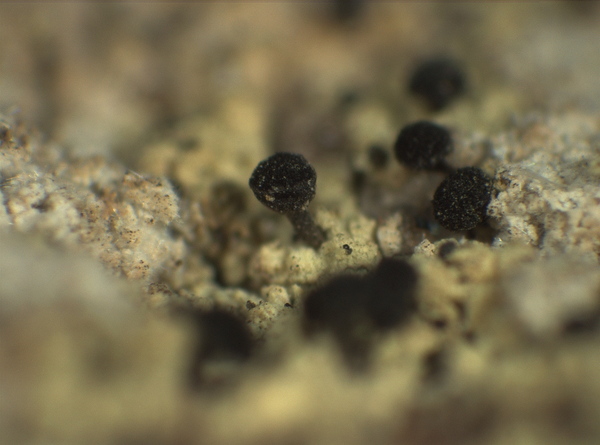

E. Pittao; Owner: Department of Life Sciences, University of Trieste
Herbarium: TSB (11836)
2008.03.10
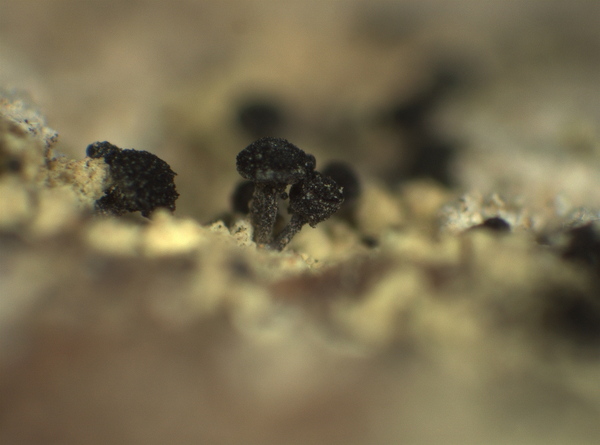

E. Pittao; Owner: Department of Life Sciences, University of Trieste
Herbarium: TSB (11836)
2008.03.10
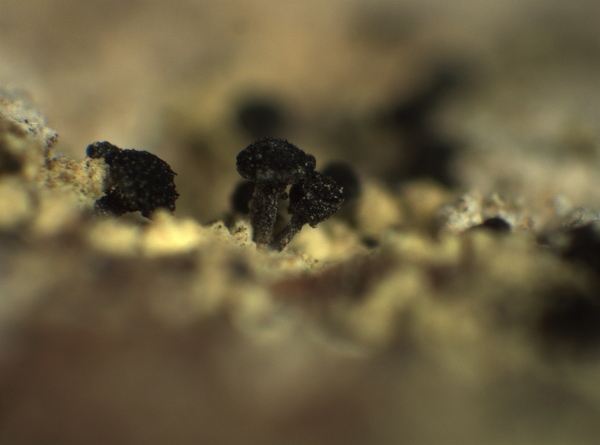

E. Pittao; Owner: Department of Life Sciences, University of Trieste
Herbarium: TSB (11836)
2008.03.10


E. Pittao; Owner: Department of Life Sciences, University of Trieste
Herbarium: TSB (11836)
2008.03.10
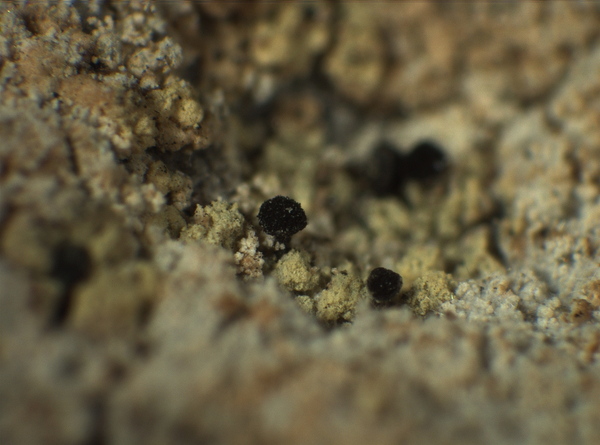

E. Pittao; Owner: Department of Life Sciences, University of Trieste
Herbarium: TSB (11836)
2008.03.10


E. Pittao; Owner: Department of Life Sciences, University of Trieste
Herbarium: TSB (34219)
2008.03.10
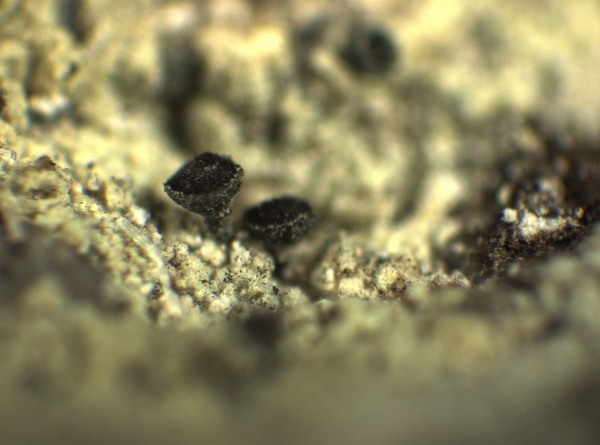

E. Pittao; Owner: Department of Life Sciences, University of Trieste
Herbarium: TSB (34219)
2008.03.10
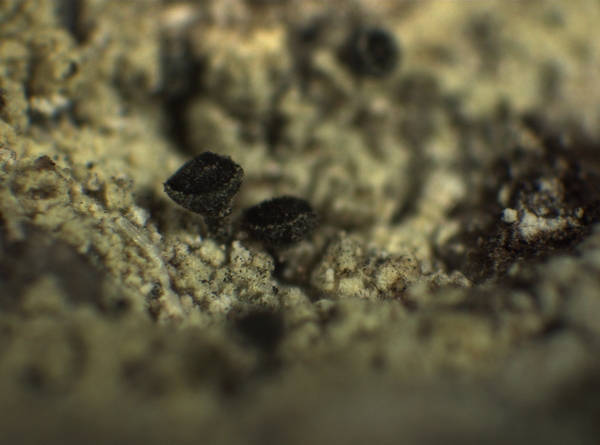

E. Pittao; Owner: Department of Life Sciences, University of Trieste
Herbarium: TSB (34219)
2008.03.10
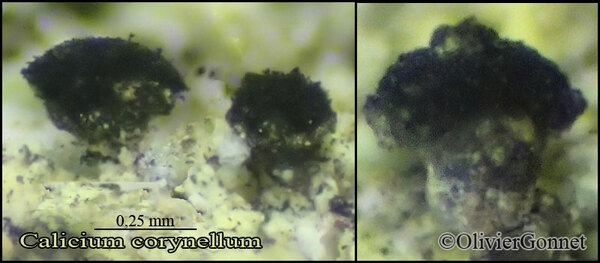
Courtesy: Olivier et Danièle Gonnet - Source: https://www.afl-lichenologie.fr/Photos_AFL/Photos_AFL_C/Textes_C6/Calicium_corynellum.htm
France, Roussillon-en-Morvan - Saône-et-Loire - (71) - gorges de la Canche, alt. 500 m, sur rocher siliceux
8/7/2015
Growth form: Crustose
Substrata: rocks
Photobiont: green algae other than Trentepohlia
Reproductive strategy: mainly sexual
In underhangs rarely wetted by rain
Commonnes-rarity: (info)
Alpine belt: absent
Subalpine belt: absent
Oromediterranean belt: absent
Montane belt: very rare
Submediterranean belt: extremely rare
Padanian area: absent
Humid submediterranean belt: very rare
Humid mediterranean belt: absent
Dry mediterranean belt: absent

Predictive model
| Herbarium samples |


P.L. Nimis; Owner: Department of Life Sciences, University of Trieste
Herbarium: TSB (26121)
2003/03/12


E. Pittao; Owner: Department of Life Sciences, University of Trieste
Herbarium: TSB (11836)
2008.03.10


E. Pittao; Owner: Department of Life Sciences, University of Trieste
Herbarium: TSB (11836)
2008.03.10


E. Pittao; Owner: Department of Life Sciences, University of Trieste
Herbarium: TSB (11836)
2008.03.10


E. Pittao; Owner: Department of Life Sciences, University of Trieste
Herbarium: TSB (11836)
2008.03.10


E. Pittao; Owner: Department of Life Sciences, University of Trieste
Herbarium: TSB (11836)
2008.03.10


E. Pittao; Owner: Department of Life Sciences, University of Trieste
Herbarium: TSB (11836)
2008.03.10


E. Pittao; Owner: Department of Life Sciences, University of Trieste
Herbarium: TSB (34219)
2008.03.10


E. Pittao; Owner: Department of Life Sciences, University of Trieste
Herbarium: TSB (34219)
2008.03.10


E. Pittao; Owner: Department of Life Sciences, University of Trieste
Herbarium: TSB (34219)
2008.03.10

 INDEX FUNGORUM
INDEX FUNGORUM
 GBIF
GBIF
 DOLICHENS
DOLICHENS
